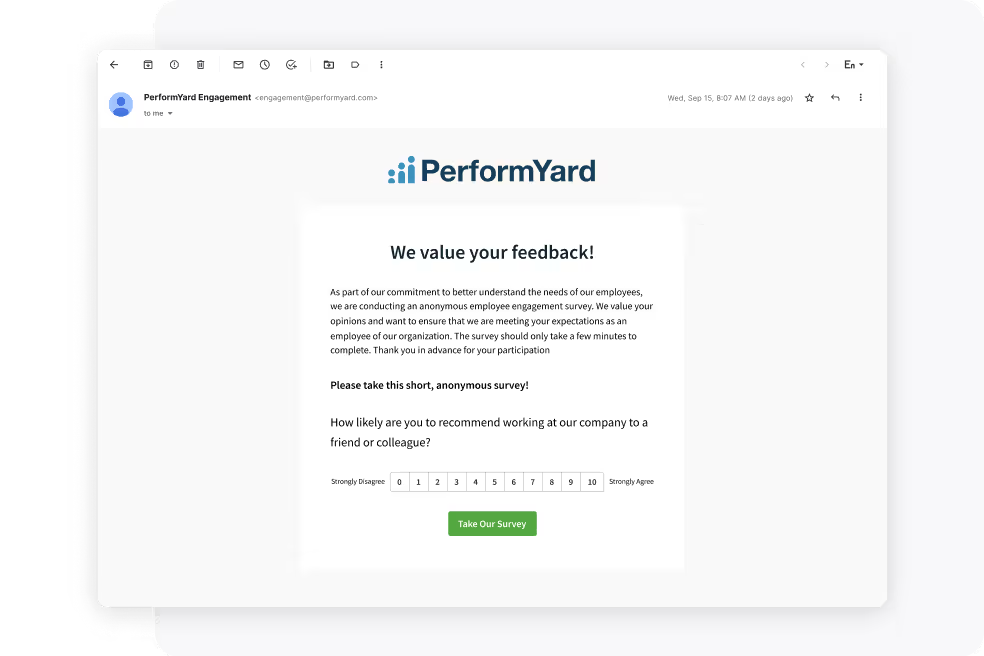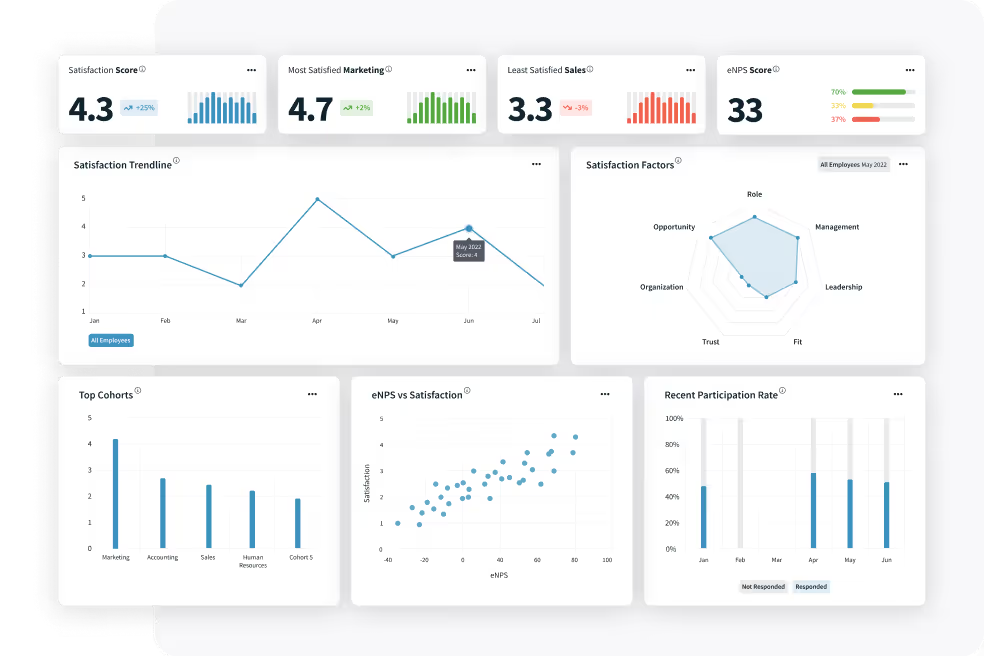The State of Healthcare Employee Engagement in 2025
Working in the healthcare industry can be extremely rewarding, but it also comes with a lot of challenges. Many of those challenges were exacerbated during the COVID-19 pandemic, leaving healthcare employee engagement in 2021 in shambles. Long hours in overburdened clinical settings caring for sick patients caused disengagement and burnout among nurses, many of whom left the profession altogether.
The good news is that engagement is on the upswing. For the first time since the pandemic, overall healthcare engagement has risen from 4.02 to 4.04 out of five, with nurse engagement rising from 3.85 to 3.89. But that only tells part of the story.
Retention continues to be a problem, with one in five healthcare workers in 2022 leaving by 2023. Turnover is an even bigger problem among new hires and nurses.
How can engagement be increasing, but turnover is still a big problem? The answer lies in the unique role of a healthcare worker. Nurses, doctors, and other healthcare professionals can be highly engaged when it comes to patient care, but engagement is more than just how employees approach patients. An engaged healthcare professional is also emotionally and intellectually connected to their hospital, coworkers, and leadership, which is where things often fall short.
The question is, how can healthcare improve employee engagement?
Keep reading to discover why engagement is so important in the healthcare industry, what you can do to increase engagement, and which employee engagement trends in healthcare will make supporting engagement in a clinical setting easier.
Current Trends in Healthcare Employee Engagement
- Emphasis on Diversity, Equity, and Inclusion (DEI): Healthcare organizations are increasingly focusing on DEI initiatives to create a diverse, inclusive workforce where all staff feel valued. An inclusive culture fosters a sense of belonging, which in turn boosts engagement and retention. In fact, healthcare teams that invest in DEI training and policies have reported improvements in workplace culture, indicating that inclusivity is directly linked to higher employee engagement.
- Prioritizing Employee Well-Being and Mental Health: Addressing burnout and stress has become a top trend as the industry recognizes the toll of the past few years. Nearly 46% of healthcare workers reported feeling burned out in 2022, a sharp rise from 32% in 2018. In response, hospitals and health systems are expanding mental health resources – from stress management programs and counseling services to Employee Assistance Programs (EAPs) – to support staff well-being. These efforts not only improve employees’ mental health but also enhance retention and job satisfaction by showing workers that their well-being is a priority.
- Flexible Work Arrangements and Work-Life Balance: Even in traditionally rigid healthcare settings, there is growing demand for flexible scheduling options. Organizations that offer hybrid roles, adjustable shift hours, or other flexible arrangements are finding it easier to attract and retain talent. Allowing healthcare employees more control over their schedules helps reduce burnout and improves work-life balance, which keeps staff more engaged and motivated while still maintaining quality patient care.
- Data-Driven Engagement Strategies: Healthcare HR teams are leveraging data and analytics to inform their engagement initiatives. By measuring employee engagement levels (through surveys, feedback tools, and HR analytics) and analyzing performance data, leaders can pinpoint problem areas and tailor strategies to boost satisfaction and performance. Advanced tools like predictive analytics are also being used for workforce planning – for example, forecasting staffing needs and identifying turnover risks – so that interventions can be deployed proactively to maintain a supportive work environment.
- Leveraging AI and Technology to Support Staff: The rise of artificial intelligence and digital tools is shaping employee engagement in healthcare. AI can automate routine administrative tasks and streamline workflows, which reduces burdens on staff and frees up time for direct patient care. Many organizations are also implementing new tech platforms (such as mobile wellness apps or AI-driven training modules) to personalize the employee experience. Importantly, employees are being upskilled to work alongside these technologies – executives estimate about 40% of the healthcare workforce will need reskilling in the next two years to adapt to AI and automation advancements. Embracing these innovations can improve efficiency and help employees feel more supported in their roles, as long as hospitals invest in the necessary training and change management.
Each of these trends reflects the current focus in U.S. healthcare on creating an engaged, resilient workforce. By fostering inclusive culture, caring for staff well-being, offering flexibility, using data insights, and embracing technology, healthcare leaders and HR professionals can drive higher employee engagement – which ultimately leads to better patient care and organizational performance.
Importance of Employee Engagement in Healthcare
Following best practices for employee engagement is important in every industry, but the importance of employee engagement in healthcare is especially significant because it can directly impact patient care and outcomes.
According to a Press Ganey employee engagement study that involved over 1.72 million healthcare employees across more than 4,500 facilities, those with the highest workforce engagement levels are most likely to be recommended by patients. Even more importantly, research has shown that staff engagement is correlated with positive patient outcomes.

Employee engagement is important when it comes to patient care, but it’s also important to the organization as a whole. Disengaged employees are twice as likely to get a job elsewhere than those who are highly engaged. Increasing engagement increases retention, which means you can avoid staffing shortages and the steep costs associated with replacing essential employees.
What Are the 4 Essentials of Employee Engagement?
Understanding the importance of employee engagement in healthcare is a vital first step to making changes, but what does engagement actually mean? In order to support a more engaged workforce, you have to break down engagement into four essential parts:
- Building trust within healthcare teams and leadership
- Ensuring recognition and reward systems are in place
- Providing opportunities for professional growth and development
- Fostering a sense of purpose in healthcare environments
Building trust within healthcare teams and leadership
Trust is the foundation of patient relationships, but it is also the foundation of all the other relationships within your organization. Nurses should feel like they’re part of a collaborative team, and they should feel like they have access to leaders within the organization who are responsive to their needs.
One of the quickest and easiest ways to build a sense of trust among employees is to give them some autonomy. For example, nurses who are involved in the decision-making process are more likely to be engaged than nurses who are expected to adhere to changes without offering their input.
Ensuring recognition and reward systems are in place
It isn't uncommon for healthcare workers to feel unappreciated. Daily responsibilities can be physically and emotionally demanding, which can leave nurses, doctors, and other workers feeling like their job is thankless.
An engaged workforce is one that feels appreciated, which means you have to create a system of recognition and rewards. Continuous feedback software is a good first step. It enables employees to give real-time feedback, including peer-to-peer feedback. And because you can document all achievements on a single platform, you can uncover outstanding performance and celebrate achievements individually, as a team, or organization-wide.
Providing opportunities for professional growth and development
Professional development is important in the healthcare field for keeping knowledge and skills up-to-date, but it's more than that. Nurses and other healthcare workers personally value professional development.
Not only should healthcare professionals engage in necessary training and development, they should also have the ability to choose their own professional growth opportunities. Whether through tuition reimbursement programs, attendance at a convention, or mentor-mentee relationships, employees should have the opportunity to pursue the professional development opportunities that align with their personal and professional goals.
Fostering a sense of purpose in healthcare environments
Most healthcare workers get into the field because they want to help people, but that feeling doesn’t always last. It’s easy to wonder about the point of it all when you deal with a never-ending stream of patients, especially if you don't feel like you have any control over the pace at which you see patients or how they’re treated.
It’s important to foster a sense of purpose in healthcare environments. That means asking employees to dig deep into exactly what their purpose is. Goal management software gives healthcare employees the ability to create personal goals. It also gives supervisors and HR the ability to align personal goals with organizational goals. Everyone is on the same page about the purpose of the organization with personal goals that make achieving that purpose clear and attainable.
How Healthcare Can Improve Employee Engagement
In addition to making changes that support the four essentials of employee engagement, there are also some more explicit ways you can improve engagement. Each one listed below includes healthcare employee engagement examples so you can see how you can make changes in your organization.
- Implementing effective communication channels
- Role of leadership in promoting engagement
- Using technology and data to personalize the employee experience

Implementing effective communication channels
Communication is extremely important in a healthcare setting. Not only does clear communication contribute to better patient outcomes, but it also impacts engagement and job satisfaction among employees. In one study, researchers found a direct connection between the communication skills of nurse managers and nurse job satisfaction.
Maintaining lines of communication helps healthcare workers feel seen, especially during stressful experiences, and it can promote an environment where everyone feels like they're in it together.
Use one-on-one meeting software to create a system of regular check-ins. This gives all healthcare employees the opportunity to talk about their concerns and review their goals on a regular basis.
It’s also a good idea to dive into your existing communication platforms and see how they can be improved. Streamlining communication channels makes it easier for employees to communicate with each other. For example, you might decide on a text-based system for day-to-day operations and use performance management software to collect all performance-related communications.
Role of leadership in promoting engagement
The relationship between leadership and other employees is extremely important to engagement. Workers who have weak relationships with leadership are 44% more likely to leave for another job. Strengthening that relationship has the potential to boost engagement so employees are more likely to stick around.
Start by supporting your leaders. Make sure they have the training to do their jobs well, even if it means taking time out of the day to attend conferences and professional development classes.
Then, give leaders time to not only listen to workers, but to act on the feedback they receive. For example, you can use employee engagement software to send out surveys to employees. Then, leaders can discuss the results and work with employees on ways to make improvements.
Using technology and data to personalize the employee experience
The employee experience in healthcare in 2024 can feel lonely. It’s easy for healthcare providers to spend their days caring for others while feeling like their own needs aren’t being recognized.
Using the power of technology and data can be hugely helpful. For example, goal check-in software gives leaders, managers, and employees the ability to create personal goals, get support, and celebrate achievements. Because a single platform stores all data, you can use the data collected from a wider performance management process to uncover insights and make changes that enhance the employee experience.
A performance-based platform can also help you uncover meaningful information about each employee's skills, interests, and aspirations, which can further enable you to personalize each employee’s role within your organization.
Schedule a free PerformYard demo to see how you can nurture employee engagement with employee surveys, goal management, the latest analytics capabilities, and more.





